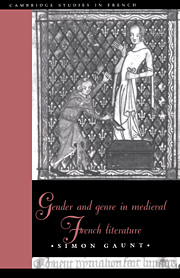Book contents
- Frontmatter
- Contents
- Acknowledgements
- List of abbreviations
- Introduction
- 1 Monologic masculinity: the chanson de geste
- 2 The knight meets his match: romance
- 3 Troubadours, ladies and language: the canso
- 4 Saints, sex and community: hagiography
- 5 Genitals, gender and mobility: the fabliaux
- Conclusion
- Notes
- Bibliography
- Index
- CAMBRIDGE STUDIES IN FRENCH
3 - Troubadours, ladies and language: the canso
Published online by Cambridge University Press: 24 August 2009
- Frontmatter
- Contents
- Acknowledgements
- List of abbreviations
- Introduction
- 1 Monologic masculinity: the chanson de geste
- 2 The knight meets his match: romance
- 3 Troubadours, ladies and language: the canso
- 4 Saints, sex and community: hagiography
- 5 Genitals, gender and mobility: the fabliaux
- Conclusion
- Notes
- Bibliography
- Index
- CAMBRIDGE STUDIES IN FRENCH
Summary
Critics agree that ‘courtly love’ has its origin in the troubadour canso. Yet the traditional literary historical narrative according to which romanciers like Chrétien de Troyes draw on an earlier Occitan lyric tradition is dubious. We know of few troubadours active before 1150 and it is unwise to generalize on the basis of the small number of songs by Guilhem IX and Jaufré Rudel or the large, but idiosyncratic corpus of the satirist Marcabru. If a new style of love poetry was emerging in some Occitan courts between 1100 and 1150, recent research suggests these courts were few and far between: in all likelihood few songs from the period survive because there were few poets. Bernart de Ventadorn, the first troubadour in whose work the conventions of the courtly canso seem fully formed, was a contemporary of early romance writers. He worked in France and England, as well as Occitania, and he probably knew Chrétien. The classic period of troubadour poetry (c. 1160–c. 1210), from which the majority of surviving songs date, is the same as the period in which the first important spate of romances was produced. Modern criticism has been so obsessed with origins that it has been more than a little blind to the contemporaneity of the Northern French romance and Occitan lyric traditions.
- Type
- Chapter
- Information
- Gender and Genre in Medieval French Literature , pp. 122 - 179Publisher: Cambridge University PressPrint publication year: 1995



